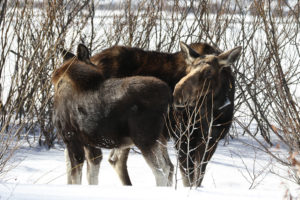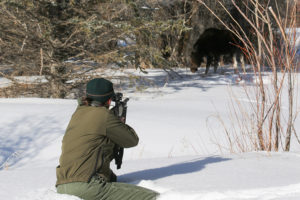In a close-up video taken by the Wyoming Game and Fish Department last week, just the end of a bulbous moose nose is visible against the snow. The moose’s pink tongue droops out of the side of its mouth while the massive animal snores. Out of the frame, a small team including Aly Courtemanch takes blood samples and performs other tests on the ungulate.
“Getting the privilege, I guess, to handle a moose, an animal that big and really majestic as a moose, is really one of the coolest parts of our jobs,” Courtemanch said. “A day like that makes you happy to be a wildlife biologist in Jackson Hole.”
Putting moose to sleep is a necessary part of collaring them with a GPS tracker. Courtemanch said her team has collared 23 moose in the area around the Snake River Bridge, including six new moose last week, since a joint project by Game and Fish and the Wyoming Department of Transportation launched in 2019. The project’s goal is to collect data about moose movements ahead of a planned replacement of the bridge, which is scheduled to start in 2023.
“We have really excellent road kill data for this area that shows that it is a really high mortality, high spot for wildlife vehicle collisions,” Courtemanch said, “[but] we were really lacking data on live animal movements in the area. We had never collared moose in this area prior to this project.”

Preliminary data from the joint Game and Fish and WYDOT moose collaring project shows that many moose cross Highway 22 and Highway 390 frequently around the Snake River Bridge. (Courtesy of Wyoming Game and Fish Department)
The GPS collars record the location of the moose wearing them every 30 minutes. Game and Fish gets that data every two or three days, which will help biologists and WYDOT decide where to build new wildlife underpasses. From the data they’ve collected so far, Courtemanch said one major finding is clear.
“Some of these moose are crossing major highways a lot,” she said.
For example, one collared female crossed either Highway 22 (Teton Pass Highway) or Highway 390 a total of 115 times in less than two years. Courtemanch said that makes her feel confident the underpasses will be a worthwhile community investment. Game and Fish public information specialist for the Jackson and Pinedale regions Mark Gocke added that he’s grateful for widespread local support to reduce too often deadly collisions between wildlife and motorists.
“We’re very fortunate to live in a place that has a lot of ungulates and in close proximity [to us]. The downside to that, of course, there’s conflicts,” Gocke said. “We’re really trying hard in all the different ways that we know how to correct this.”

Courtemanch takes aims to dart a moose for GPS collaring. (Courtesy of Wyoming Game and Fish Department)
Despite working with a skeletal team because of the coronavirus pandemic, Courtemanch and Gocke said this year’s round of captures went smoothly thanks in part to numerous tips from residents in the Wilson, Westbank and Snake River areas about where to find moose. The process still takes some searching by the Game and Fish team, though.
“Every morning at first light, we would kind of spread out in separate vehicles and start driving around and just looking for moose that might be available and in good places for us to dart and capture them,” Courtemanch said, explaining that the team had to avoid roads, water and other hazards. “If they’re in a safe place, we go ahead and we dart that animal with an anesthetic that basically, you know, puts it to sleep.”
Another video provided to KHOL by the Game and Fish Department shows this process—Courtemanch carefully aims and fires a dart into the left rear haunch of a moose nibbling on some shrubs.
After a moose is shot with the anesthetic, Courtemanch said it usually takes about 10 minutes for it to lay down and fall asleep—hopefully remaining somewhat upright.
“You’re just hoping that you don’t have to move them much because it’s a major chore to do that,” Gocke said. “When they go down you want them to be what we call sternal… not laying completely on their side. We’ve been fortunate. They’ve all been really good at laying down.”
At that point, the team can proceed with collaring the moose and other data collection.
“We take a number of different health samples, blood samples. We have a student working with us who’s looking at winter ticks on the moose,” Courtemanch said, “so, we’re collecting a lot of different information since we’re fortunate to have that moose in hand.”
The whole process only takes about 15-20 minutes before the team is ready to administer a reversal drug, after which Courtemanch said the moose generally get back on their feet within another five to 10 minutes.
“They are usually snacking and getting back to being a moose,” she said with a laugh.
The moose also don’t have to wear their new collars forever. The devices are designed to fall off after two and half years—hopefully in a location where Game and Fish employees can easily go out and retrieve them.





